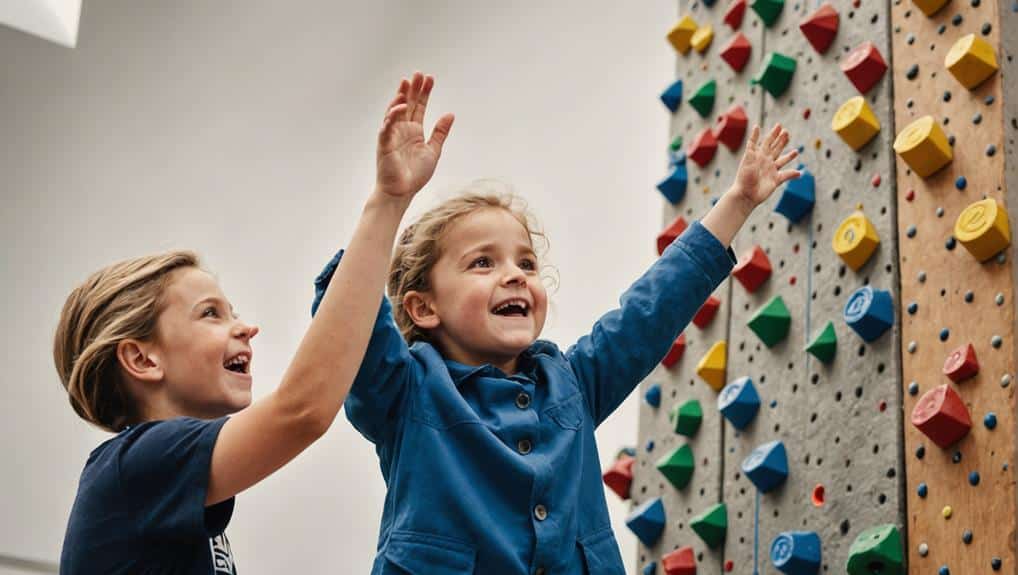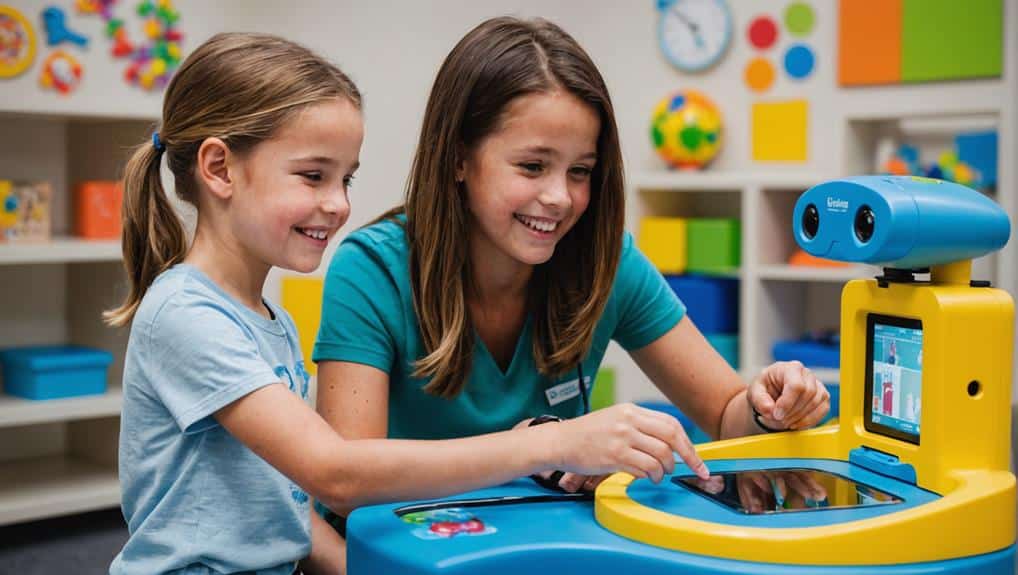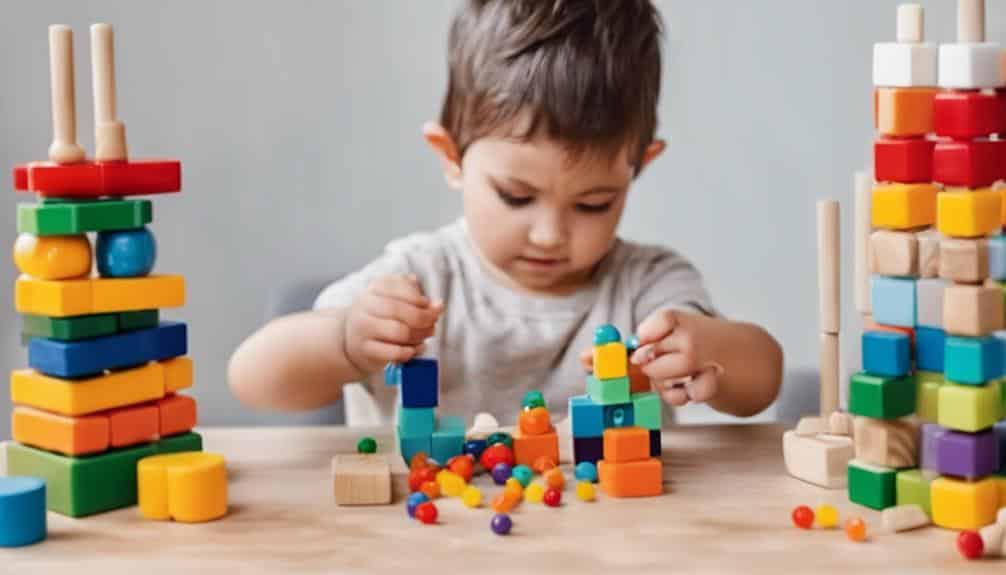Key Takeaways
- Pediatric occupational therapy provides holistic development tailored to a child’s needs, including addressing developmental delays.
- The therapy enhances children’s self-esteem by improving their motor skills and ability to perform daily tasks independently.
- Evaluations and goal-setting in pediatric occupational therapy monitor progress, adjust goals, and design interventions for individual improvement.
- Therapy interventions include sensory integration techniques, fine motor skill exercises, and play-based therapy approaches integrated with education.
- Advancements in pediatric therapy, like virtual reality technology, sensorimotor equipment, and respect for cultural differences, contribute to improved therapy outcomes.
Defining Pediatric Occupational Therapy
Pediatric Occupational Therapy, a field of healthcare with a specific focus, plays an essential role in the holistic development of children. This specialized therapy domain assists children in acquiring critical skills necessary for daily activities and participation. With techniques that often incorporate aspects of the DIR/Floortime Model, Pediatric Occupational Therapists work with children who encounter challenges related to motor skills, sensory processing, social interaction, and cognitive issues.
The therapy is tailored to meet each child’s needs, nurturing their active involvement in their surroundings. Techniques used aim to promote independence, thereby enabling children to reach their maximum potential. This is accomplished through addressing developmental delays and enhancing the child’s autonomy, often using personalized care and relationship-building strategies.
Pediatric Occupational Therapy not only works directly with children but also offers invaluable guidance to families. This support assists in long-term progress, ensuring that the child can continue to develop and thrive even beyond the therapy sessions. By embracing a child-focused approach, Pediatric Occupational Therapists make a significant contribution to the well-being and growth of children, ultimately guiding them toward a rewarding and self-reliant life.
Importance of Family Involvement
Integral to the success of pediatric occupational therapy is the active involvement of the family. Approaches like DIR/Floortime can significantly improve the child’s engagement and interaction. Family participation optimizes therapeutic outcomes and ensures the child’s comprehensive development. Through this collaborative effort, occupational therapy best helps children by extending the benefits of treatment beyond the clinical setting and into the home.
It is essential to equip families with tools and techniques to support their child’s development—such as involvement in the child, reinforcing skills learned during therapy, and encouraging consistent progress. Furthermore, involving families in goal-setting and progress tracking fosters a collaborative approach. This partnership between the therapist, child, and family anchors the therapy in a shared commitment to improving the child’s development.
Family engagement in pediatric child’s therapy also yields significant additional benefits. It improves communication, strengthens relationships, and supports the child’s well-being. Therefore, the importance of family involvement in pediatric occupational therapy cannot be overstressed. It is a cornerstone of a child’s developmental voyage, fostering resilience, growth, and childlessness.
Boosting Child Self-Esteem

Elevating a child’s self-worth is a crucial aspect of pediatric occupation. This treatment branch is dedicated to uplifting your child’s confidence and nurturing independence. Emphasis is placed on facilitating the child’s ability to adapt to sensory inputs, an essential element in managing a child’s sensory processing disorder. By focusing on tasks the child can accomplish, pediatric occupational therapists can create a supportive environment that improves skill development and fosters healthy self-worth.
Pediatric Occupational Therapy assists in:
- We identify and set achievable goals, which can significantly improve a child’s self-worth and sense of accomplishment.
- Celebrating progress and milestones during the child’s learning reinforces positive behavior and further uplifts a child’s self-worth.
- They encourage children to feel capable and confident in their abilities and promote a positive self-image.
Enhancing self-worth in children has extensive benefits. Children with high self-worth are likelier to take on new challenges, persevere in complex tasks, and show resilience in the face of failure. Through pediatric occupational therapy, we can give children the tools they need to believe in themselves and their abilities, laying the foundation for a healthy, confident adulthood.
Evaluating Developmental Milestones
As we further examine the multifaceted benefits of pediatric occupational therapy, we focus on the critical process of evaluating developmental milestones. This assessment is crucial as it thoroughly overviews a child’s growth and development, identifying potential delays or challenges in motor skills, sensory processing, and social interactions.
Equally significant is the understanding that each developmental stage builds on completing the previous stages, establishing the foundation for developing fine motor skills such as writing, cutting, and even opening lunch boxes. The Fine Motor Development Chart is a functional screening tool to monitor and support children’s skill development.
Evaluating these milestones enables occupational therapists to tailor interventions, addressing specific needs to promote optimal development. This targeted approach to children’s therapy is a standard solution and a personalized strategy designed to enrich the child’s overall growth and well-being.
Regular assessment of developmental milestones is also crucial in tracking progress. It allows for dynamic adjustment of therapy goals in sync with the child’s development, guaranteeing that the child is constantly moving forward, albeit at their rhythm.
Steps Toward Developmental Progress

In pediatric occupational therapy, setting attainable goals is a cooperative effort that involves the child and their family. This process is essential in identifying any possible developmental delays affecting the child’s fine and gross motor skills, communication, speech, cognitive, and adaptive abilities. Customizing interventions to the child’s interests and specific requirements guarantees that these goals tackle their challenges. Children utilize their strengths, establishing a motivating environment for developmental progress. This tailored approach supports ichild’sence in everyday activities and nurtures a deep-seated drive to pursue ongoing growth and development.
Setting Achievable Goals
The foundation of successful pediatric occupational therapy lies in creating attainable objectives that direct a child’s growth. These objectives are not randomly chosen but instead collaboratively devised with the child and family’s input. This collaborative approach ensures that the objectives align with the child’s interests, capabilities, and specific requirements, making occupational therapy a tailored expedition toward developmental advancement.
An integral part of this family is the child’s ability to engage in and accomplish daily activities. The child’s is closely linked to their endurance for activities. The child’s sessions can include practical interventions, like participating in basic meal preparations or practicing toilet transfers. These interventions, adjusted according to the child’s needs, can significantly improve the endurance for activities, thereby enhancing their overall developmental progress.
These personalized objectives act as stepping stones, providing a clear path for the child’s developmental journey. This makes the child process less daunting and more captivating for the child. The advantages of establishing such attainable objectives in pediatric occupational therapy include:
- Fostering independence and skill development
- Identifying areas for enhancement and monitoring progress over time
- Boosting motivation and involvement in therapy sessions
Occupational therapy thus plays a pivotal role in a child’s development by setting attainable objectives. These objectives serve as guiding lights, directing each child towards their path of progress and growth. This process nurtures developmental skills and cultivates a sense of achievement and self-child in the child, contributing to their overall wellness.
Designing Tailored Interventions
Indeed, a child’s developmental path is unique and demands a personalized approach to nurture growth and progress. This is where customized interventions come into play. These interventions, rooted in thoroughly evaluating a child’s strengths and needs, form the core of therapy. Incorporating activities that promote fine motor skill development, such as using building blocks or coloring, can be a crucial aspect of these interventions.
Crafting these interventions, however, is not a onechild’sprocess. It involves collaborative goal-setting with the child and their family, ensuring a focused and family-centered approach toward achieving developmental goals. Parents can actively participate and support their child’s progress by offering toys like pegboards or beads. The planning incorporates the child’s interests, fostering an environment of active participation and engagement. This approach promotes independence and encourages the child to take ownership of their progress.
Addressing motor development issues is an essential aspect of interventions. By strategically focusing on the children’s issues, occupational therapists enable children to gain independence in their daily activities, nurturing their self-confidence and autonomy.
In essence, by concentrating on specific developmental goals through personalized therapy, pediatric occupational therapists play a crucial role in guiding children toward critical developmental milestones, thus significantly enhancing their overall well-being. The impact of tailored interventions in facilitating a child’s developmental path cannot be emphasized enough.
Addressing Motor Development Issues
Comprehending and addressing motor development issues constitute a central pillar of pediatric occupational therapy, necessary for nurturing a child’s independence and daily life functionality. Pediatric occupational children focus intently on improving fine and gross motor skills, paving the way for a child’s successful engagement with the world around them. They utilize their expertise in identifying gross motor skills deficiencies and interventions accordingly, which can significantly impact the child’s development and participation in physical activities like running and jumping.
These therapists offer a variety of customized interventions and exercises designed to strengthen children’s abilities and overcome developmental delays or challenges. Their efforts aim to boost children’s strength, postural control, and balance, all vital components of motor skills development.
Consider the following impacts of this necessary therapy:
- *once frustrated by the inability to grasp a child’s, a child grappling with fine motor skills may eventually write their name with pride.*
- *A child struggling with gross motor skills could transform from a shy observer into an active participant in playground activities.*
- *Early intervention can alleviate existing challenges and anticipate future struggles, greatly influencing a child’s ability to perform daily tasks independently.*
As caring caregivers, we recognize the profound effects of successfully addressing motor development issues on a child’s life, making this a primary focus of pediatric occupational therapy.
Sensory Processing Assistance Techniques

In pediatric occupational therapy, sensory processing support techniques are crucial in nurturing a child’s capacity to engage in daily activities comfortably. These techniques focus on regulating sensory child’s ability to respond appropriately to their surroundings. This can involve addressing hypersensitivity or hyposensitivity to stimuli, common sensory processing issues prevalent in children, or a combination of the two.
Tailored Child’s innovations are designed to help children overcome sensory challenges and are a significant part of pediatric occupational therapy to enhance sensory integration. These interventions, often in sensory activities, are developed considering each child’s needs. This individualized approach marks a significant advantage of this therapeutic method.
Occupational therapists utilize environmental modifications and sensory diets as extra resources. These approaches help children with sensory processing challenges regulate their responses to stimuli, promoting a more balanced interaction with their surroundings.
In essence, sensory processing support in pediatric occupational therapy enables children to partake in and enjoy activities without discomfort or sensory overload. The ultimate goal is to foster improved engagement and participation in diverse activities, enhancing a child’s comprehensive development and quality of life.
Integrating Therapy With Education
While pediatric occupational therapy significantly contributes to a child’s sensory processing abilities, its benefits extend beyond this domain. It helps to build skills and improve aspects important for educational progress, such as concentration, self-regulation, and organization. One teacher approach that encourages child development and learning is the DIR/Floortime method. This method involves child-led play and interaction, emphasizing the significance of relationships in child development. Collaborating with educators and occupational therapists ensures a holistic approach to a child’s development, integrating therapy with education.
This amalgamation of therapy and education offers several advantages:
- It creates a cohesive strategy that targets the child’s academic and social needs, enhancing their overall growth.
- It allows for the practical application of skills learned in a therapeutic setting within the educational environment.
- It paves the way for a child’s prosperous future by equipping children with vital life skills.
The union of pediatric occupational therapy and education offers a complete approach to learning development. By collaborating with educators, the therapist ensures that the child’s needs are met, not just in the therapy room but also in the classroom, thereby paving the way for a more independent and prosperous future.
Types of Therapy Interventions

In pediatric occupational therapy, different intervention strategies are employed to cater to each child’s distinct needs. These include sensory integration techniques to assist children in managing their siblings and fine motor skill exercises to improve hand-eye coordination and manual dexterity. Moreover, play-based therapy interventions are utilized, grounding the therapeutic process in familiar and engaging activities that children naturally gravitate toward.
Sensory Integration Techniques
Sensory integration techniques emerge as a pivotal aspect of pediatric occupational therapy in addressing sensory processing challenges. These techniques are designed to improve children’s ability to process sensory input, thereby assisting them in better participating in everyday activities.
Occupational therapists employ a range of sensory integration interventions tailored to specific needs. This includes creating customized “sensory diets” – a distinct set of activities that help children regulate their sensory experiences effectively. The aim is to alleviate sensory processing challenges such as hypersensitivity or hyposensitivity and enhance sensory experiences.
- Through sensory integration, children learn to manage their sensory responses, nurturing their ability to interact with the world around them.
- By addressing sensory processing challenges, we enable children to overcome obstacles, boosting their confidence and self-esteem.
- Tailored sensory diets offer a practical, personalized approach that respects each child’s needs and experiences.
Incorporating sensory integration techniques into pediatric occupational therapy can transform a child’s life. By understanding and addressing sensory processing challenges, we can help children engage fully in the world around them, promoting their overall development and well-being.
Fine Motor Skill Exercises
Occupational therapy extends beyond sensory integration techniques to vital areas like fine motor skill exercises. These exercises, pivotal in pediatric occupational therapy, are designed to improve hand-eye coordination and promote the development of precise hand movements.
Fine motor skill exercises particularly benefit children, equipping them with skills necessary for various tasks—from writing and drawing to cut therapy’s buttoning. Everyday tasks, such as feeding, dressing, and grooming, that we often take for granted depend on these fine motor skills. By refining these skills, children can perform these tasks independently, fostering a sense of self-reliance and confidence.
Therapy interventions often incorporate engaging activities such as tweezers, threading beads, or completing puzzles. These enrich fine motor skills and make the therapy sessions enjoyable for children. A vital aspect of pediatric occupational therapy is tailoring these fine motor skill exercises to each child’s needs and abilities. This personalized approach guarantees optimal development, helping children reach their full potential.
Play-Based Therapy Approaches
Leveraging the power of play, pediatric occupational therapists employ play-based therapy approaches to foster skill development and engagement in children. This inventive method uses engaging activities, games, and toys to target specific developmental goals and overcome challenges. Through these fun and interactive interviews, children improve motor skills, sensory processing, social interactions, and cognitive abilities, which are fundamental to their everyday lives.
Here are some key benefits to emphasize:
- *Encouraging creativity and imagination:* Play-based therapy provides a platform for children to express their creativity, fostering their imagination and enhancing their problem-solving skills.
- *Boosting self-esteem and confidence:* Achieving goals through play helps children build self-esteem and confidence, paving the way for a healthy mental state.
- *Creating meaningful interactions:* Play-based therapy encourages social interactions, helping children understand and navigate their social environment better.
Respecting Cultural Differences
Cultural distinctions can undoubtedly significantly impact the effectiveness of pediatric occupational therapy interventions. Acknowledging and honoring these distinctions is crucial, not just for ethical reasons but also to improve therapy outcomes.
Therapists can cultivate a more inclusive atmosphere using translators and culturally appropriate materials. This approach enables children and their families to feel heard and respected, significantly enhancing their involvement and response to therapy.
| Techniques | Advantages |
|---|---|
| Using Translators | Ensures clear communication, reduces misinterpretations |
| Incorporating Culturally Relevant Materials | Boosts engagement, makes therapy relatable |
| Embracing a Respectful Approach | Builds trust, fosters participation |
| Integrating Inclusive Practices | Honors cultural backgrounds encourage holistic therapy |
| Tailoring Therapy | Addresses distinct needs guarantee optimal therapy outcomes |
Advancements in Pediatric Therapy

Pushing the boundaries of traditional approaches, recent advancements in pediatric therapy have transformed the field, making the therapeutic experience more engaging and interactive for children. At the heart of these progressions is integrating virtual reality technology and sensorimotor equipment, aiming to transform how occupational therapy is delivered.
Virtual reality technology offers a dynamic and immersive environment that stimulates children’s interest and participation in therapy. It can help children with developmental challenges improve their motor skills and coordination in a fun, game-like setting. Similarly, sensorimotor equipment provides inventive ways to address sensory processing issues, enriching children’s therapeutic experiences while maximizing treatment outcomes.
These advancements in pediatric therapy are pivotal for children’s development, offering:
- A more immersive therapy experience that encourages active participation.
- Creative children to enrich sensory processing and motor skills.
- An engaging, game-like environment that makes therapy fun, reducing the anxiety often associated with therapy sessions.
With empathy at the core, these advances in pediatric therapy foster children’s physical development and contribute to their emotional well-being. Indeed, the future of pediatric treatment is promising, with the potential to significantly enhance children’s lives.
Frequently Asked Questions
Why should I choose pediatric occupational therapy?
Choosing pediatric occupational therapy can significantly enhance your child’s motor skills, sensory processing, and daily independence. It provides targeted support to boost self-esteem and improve overall quality of life.
What Are the Benefits of Occupational Therapy in Pediatrics?
Pediatric occupational therapy fosters independence in children by enhancing daily life skills. It offers early intervention for improved long-term outcomes and customized plans to enhance motor skills, sensory regulation, and holistic development—children’s social skills and self-esteem.
What Is Occupational Therapy for Child Development?
Occupational therapy for child development is a personalized approach to children’s motor skills, sensory processing, and social interaction. This therapeutic process fosters self-esteem and independence and encourages participation in daily activities.
How to Explain Pediatric Occupational Therapy?
Pediatric occupational therapy involves personalized interventions to help children gain independence and improve their skills in daily activities. The focus is enhancing motor skills, sensory processing, social interaction, and cognitive abilities.
What Is the Pediatric Approach to Occupational Therapy?
A pediatric approach to occupational therapy focuses on enhancing a child’s skills needed for daily functioning. It addresses motor, sensory, social, and cognitive tasks, with personalized plans promoting independence, self-esteem, and comprehensive developmental success.
Conclusion
In summary, pediatric occupational therapy emerges as an indispensable tool in the holistic development of children. It magnifies each child’s potential, enabling them to conquer developmental hurdles confidently. As the adage goes, it takes a village to raise a child, and this therapy embodies that, involving children and respecting cultural differences. It is a guiding light of hope, illuminating a brighter, independent future for children with developmental delays.


Recent Comments